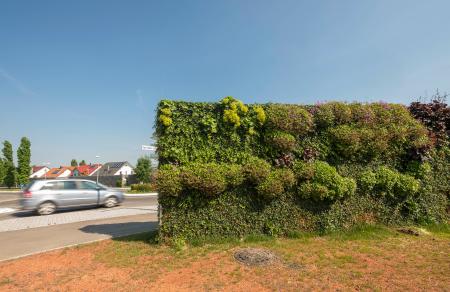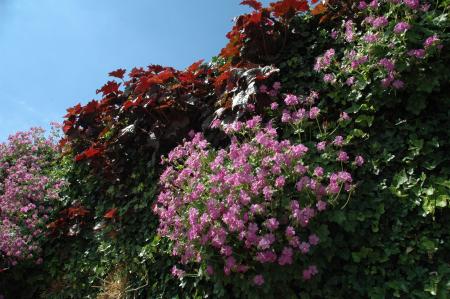
Area characterisation:
Building process of a vertical noise barrier (length 100 m, height 2.60 m ) alongside a road to block noise off a building site. Covered space 50 m². Rain water usage from nearby buildings.
Objective:
The noise barrier wall-system being used in Sachsenheim guarantees an instant green noise barrier wall, from the very first day on: The green noise barrier consists of a scaffold with galvanised steel lattice mats on both sides, filled with a core of plant substrates and then planted with pre-cultivated plant mats. Already at the time of assembly, the walls are at least fifty percent covered and they are completely green after six months.
Images
Financing:
Infrastructure activity – financed by selling the building ground
Potential impacts/benefits:
Usually, conventional noise barrier walls take years to be covered,
with Ivy or Virginia creeper being planted alongside the base of the
wall, encouraging natural growth of these plants. The green noise
barrier by Helix Pflanzen however ensures a fast, instant green solution. The leaf area index of the used system is 3 - 5 in the first year
and more than 7 starting in year two.
Lessons learnt:
In Germany noise mitigation has to be done by law. But using the structure and totally green it, is and add on that need a wide commitment in the city council - top down. Silo structures can be a problem.
Client:
City of Sachsenheim
Design team:
Helix Pflanzensysteme
Global goals:
-
3. Good Health and well being
-
9. Industry, innovation and infrastructure
-
11. Sustainable cities and communities
-
13. Climate action
NBS goals:
- Enhancing sustainable urbanization
- Improving risk management and resilience
- Urban regeneration through nature-based solutions
- Nature-based solutions for improving well-being in urban areas
- Increasing carbon sequestration through nature-based solutions
NBS benefits:
- Developing climate change adaptation; improving risk management and resilience
- Flood peak reduction
- Reduce flood risk
- Reduce load to sewer system
- Reducing temperature at meso or micro scale
- Developing climate change mitigation
- Carbon sequestration and storage
- Restoring ecosystems and their functions
- Greater ecological connectivity across urban regenerated sites
- Improve connectivity and functionality of green and blue infrastructures
- Increase achievements of biodiversity targets
- Increase Biodiversity
- Increase quality and quantity of green and blue infrastructures
- Enhancing sustainable urbanisation
- Changing image of the urban environment
- Improve air quality
- Increase accessibility to green open spaces
- Increase amount of green open spaces for residents
- Increase population & infrastructures protected by NBS
- Increase well-being
- Provision of health benefits
- Reduce costs for water treatments
- Reducing wind speed
